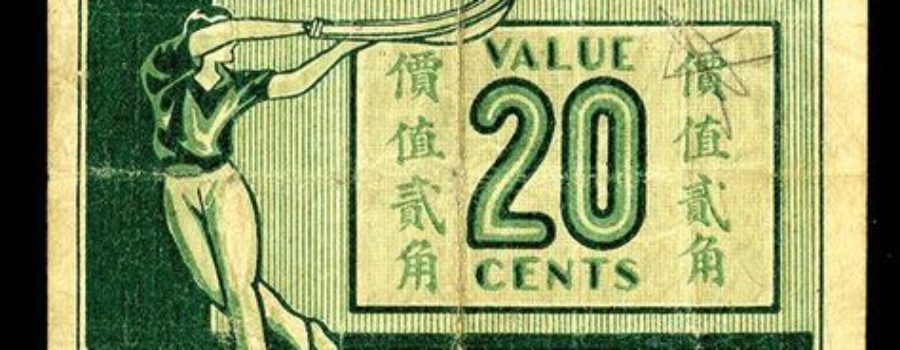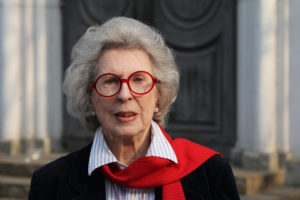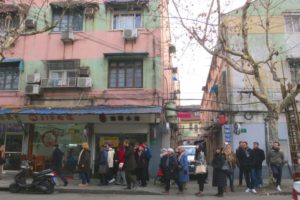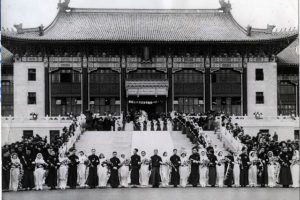Trespassing? Maybe. But nipping into buildings to see if there’s a bit of old Shanghai left sometimes yields surprising treasures. On Shaanxi Road, cranes and pylons are building a bigger, better, shinier city, giving no hint that in the midst of it all is the ghost of a long-forgotten Shanghai: the Hai Alai* Auditorium. But step inside the multiply-redone exterior of this unassuming building, and a vintage Art Deco staircase, lively racing stripe running up the walls, makes it clear that this bit of new Shanghai has a racy past.
*[Note: “Hai Alai” was the spelling used by the Auditorium; standard spelling is “Jai Alai”. We use “Hai Alai” when referring to the Auditorium and “Jai Alai” elsewhere.]
Architectural forensics (i.e. dipping into the old Shanghai Street Directories) reveals that yes, the footprint of this building matches that of part of the Hai Alai Auditorium, on the corner of Avenue Roi Albert [today’s South Shaanxi Road] and Avenue Joffre [today, Central Huaihai Road].
But … how could it still be here, hidden in plain sight? In Shanghai, renovation licenses are much easier to acquire than licenses for new construction, so completely remodeling an existing building to suit contemporary purposes is not unusual. What is unusual is the retention of any part of the old building that hints at its past – in this case, that glorious staircase.
The Hai Alai Auditorium was the brainchild of a man named Teodoro Jauregui, a Spanish Basque and talented jai alai player who wanted to bring Shanghai the fast-paced game from his native country. It was the golden age of the sport: pelotaris [jai alai players] in the 1924 Paris Olympics had captivated an international audience, and as the fever spread, frontons [jai-alai courts] were being built around the world. It was a hugely entertaining game to watch, and the fact that it could be dangerous made it even more so: Using a hand-held wicker basket (cesta), players whipped a small, hard ball against a wall at astounding speeds — sort of like squash, but with curved baskets instead of racquets. It was also an excellent sport for gambling. In Shanghai, reasoned Jauregui, he had a population with means who enjoyed entertainment and adored gambling – a perfect fit.
In 1928, Jauregui went to French entrepreneur Felix Bouvier with the idea. An accountant by training, the Frenchman had first come to Shanghai in 1914, and worked with Credit Foncier d’Extreme Orient. In 1921, he set up investment banking house Union Mobiliere with a partner, A. Holstein, and in the same year, his own accountancy practice. The financial success of Union Mobiliere gave him a surplus of cash that he invested in projects in and around the French Concession. He owned Le Grand Garage, an auto service company also on Roi Albert, and later would be one of the owners of the Canidrome, the legendary greyhound racing track.
Bouvier was an excellent choice: well connected in Shanghai – he was a member of the French Chamber of Commerce and the Cercle Sportif (French Club) – he had both the resources and the network to make it happen. He liked the idea of a jai alai fronton in Shanghai, and set up a joint stock company to build “Parc des Sports”, (known simply as “the Auditorium” in English). Jai alai was played in the Auditorium Club, and according to its entry in the 1937 Hong List, the auditorium also hosted “boxing, skating, tennis, and athletic games”.
The Auditorium, designed by architects Spence and Robinson, sported the clean, modernist lines so au courant at the time, and took up nearly the entire city block, from the corner of Avenue Joffre nearly to Nanchang Lu. After we’d posted a photo of the Auditorium on Historic Shanghai’s Facebook page, we were contacted by a gentleman who had inherited a commemorative Auditorium cigarette case from his grandfather, Santiago “Jimmy” LLado. As it turns out, LLado owned the Shanghai Stucco Company, and had done the stucco interiors for the Auditorium Annex. LLado was from Barcelona and had come to Shanghai via the Philippines, where he met his White Russian pianist wife, Ludmilla Klein. Grandson Jim shared a photo of the cigarette case, and this story:

Cigarette case with the image of the Auditorium, monogrammed with Santiago LLado’s initials. The inscription, in Spanish, reads: “A Momento from Dona H. Jauregui, 1 March 1935”.
In 1968, while working at a Scout camp in upstate New York, Jim [the grandson] had met a Chinese American camper whose father was born in Shanghai. Jim told him that his mother [LLado’s daughter] too, was born in Shanghai, and the boy asked what his mother’s and grandfather’s names were. “The following day, a limo showed up at camp with the [Chinese American] boy’s father. He asked me if my grandfather’s name was Santiago “Jimmy” LLado. I said ‘yes’, and he pulled out a picture with the two of them together. He became emotional and said that my grandfather had taken him under his wing at his firm. He also said my grandfather was very successful, influential and rich.” The search continues for more on Jimmy LLado’s time, and work, in Shanghai.

1932 jai alai player contract, with the “Shanghai Hai Alai Club” stamp. Source: www.txik-txak-zula.blogspot.com
The Auditorium opened on February 7, 1930, with Felix Bouvier as Chairman of the Board. Jauregui was the team captain and general manager, and Haig Assodourian, an Egyptian of Armenian descent, the manager. Staff included a basket (cesta) maker and ball maker. Jauregi had put together the best jai alai roster in the world, says Basque jai alai blogger Zulaika: some of the world’s most famous pelotari played here, names that still resonate for jai alai fans. These included legends like Jose Garate, a jai alai gold medalist in the 1924 Olympics. Players came from famous frontons, and from around the jai alai world: Spain, Cuba, Brazil – and were paid well. A contract for a Brazilian player named Vincete reveals that he was paid $1,350 (Mexican dollars) per month in 1932 – good money in pre-inflation Shanghai.
They played singles and doubles, up to 16 matches each night. “A fast and fascinating Spanish indoor sport …. [with] a huge amount of betting on the games,” declared the All About Shanghai guidebook in 1935. The house took 15-20% of each bet, and prospered. Most matches were fixed, and pelotari could get paid several multiples of their monthly salaries for throwing a game. Not all the patrons did as well: the Shanghainese called the sport “hai’a’la,” a word play that means to entrap you and make you even poorer.
Jack Tonnochy, Flyweight & Bantamweight Champion, recalls boxing at the Auditorium: “I had about half a dozen fights there. I wasn’t easy for a newcomer to fight at the Auditorium; in those days, the boxers who fought there had big names and followers – as for me [when I started out], I had to wait for someone to show up for whatever reason, and I sort of filled in … I remember my first fight at the Auditorium: the promoter told me he couldn’t pay me publicly, because I was underage, but ‘If you win, I’ll present you with a silver cup, then when we return to the dressing room, you return the cup and I’ll give you US$5.00.’ When I was better known, I got paid without question.”
Audiences – White Russians, Europeans, Chinese – came in droves, and business boomed. The Auditorium expanded in 1934 to a capacity of 3,000, and installed air-conditioning, heating and a circular bar. It became infused in popular culture, listed as a must-do in guidebooks of the period, and even featured in a novel. Julio Larracoechea y Gonzalez, the Spanish vice-consul in Shanghai between 1932 and 1936, penned Ramonchu in Shanghai, a novel inspired by the life of a Shanghai jai-alai player.
The Japanese invasion in August 13, 1937 closed the Auditorium for a time, and wartime brought its own dramas. In 1941, Felix Bouvier was accused of murdering Baron Reginald de Auxion d’Ruffé, a French lawyer and author (Is China Mad? 1928; China and the Chinese: The New Yellow Peril, 1926). The two had first come into conflict over the founding of the Hai Alai Club, but hostilities reached a peak in 1940 when they took opposite political sides, Bouvier supporting General de Gaulle and de Ruffe aligning with the Vichy collaborater, Petain. No evidence was ever turned up to convict Bouvier, however.
Gambling on jai alai dried up during the long war, and the fronton closed in 1944. The Wang Jingwei government rechristened the Auditorium as the Shanghai Gymnasium, the name it retained until 1975, when it was renamed the Luwan District Gymnasium following the opening of the new Shanghai Indoor Stadium (also called the Shanghai Grand Stage). Multiple renovations in recent decades have turned it into an office building with some shops at street level, and no indication on the exterior that it was once a lively center for sports and gambling. All that is left is that mysterious staircase. Poke your head in at 139 Shaanxi South Road to have a look, and wonder at the traces of Old Shanghai just under our noses, waiting for us to rediscover.
Sources:
Beltran, Juan Pablo Sanchez, “Frontones de Pelota Vasca en China” in Revista del Instituto Confucio de Valencia, Volumen 7, no. 4, Valencia, July 2011.
Djordjevic, Nenad, Old Shanghai Clubs & Associations: A Directory of the Rich Life of Foreigners in Shanghai from the 1840s to the 1950s. Hong Kong: Earnshaw Books, 2009.
Shanghai Street Directory, 1947.
Nellist, George, ed., Men of Shanghai and North China, Ed. Shanghai: The Oriental Press, 1933.
“Jai Alai Made Some, Ruined Others”, Shanghai Star, 11-08 2001
“Jai Alai in China”, in Zulaika’s Jai-Alai Blog, August 24 2009, www.txik-txak-zula.blogspot.com
All About Shanghai and Environs: A Standard Guidebook, 1934-35 Edition, Shanghai: The University Press / 1986 reprint, Oxford University Press
Jack Tonnochy, Interview, February 20, 2015.
“Glory Days of a Tough Old Basque”, Sebastian Rotella, Los Angeles Times, May 24 1992.

















Most Commented Posts